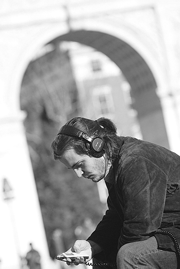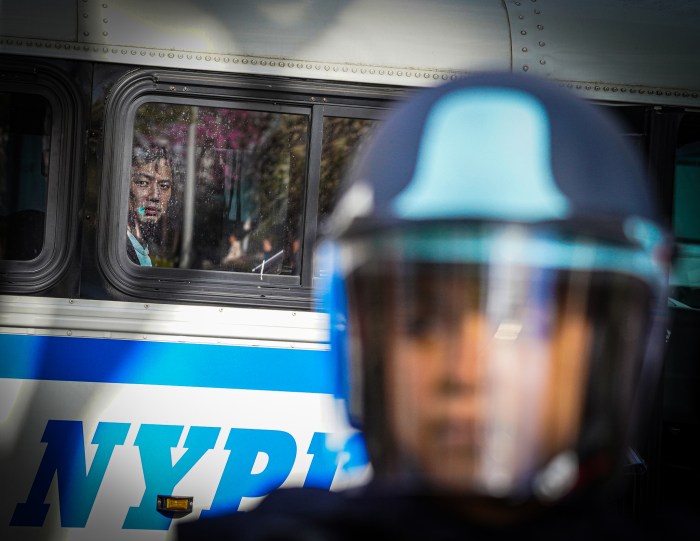By Albert Amateau
The Bloomberg administration’s new noise code, the first revision in 30 years, won overwhelming approval from the City Council at its last official meeting of the year on Dec. 21 after last-minute changes that addressed some concerns of Councilmember Alan Gerson and other critics.
At a Council Environmental Committee meeting the morning before the full Council vote, new provisions were included to allow the code to be improved during the yearlong period for drafting rules for implementing the code.
“We’ve made some progress but we still have work to do,” Gerson told The Villager on Dec. 21.
A key change was the addition of a peer review panel of acoustic experts — independent of the Department of Environmental Protection — to be created by the Council to consult with the city on implementation rules, Gerson said.
A week before the code was adopted, the 40-page bill, Intro 397A, drew strong objections from Gerson, who vowed to oppose it on the grounds that it would not relieve the unrelenting sound that plagues Tribeca neighbors from 60 Hudson St. where telecommunications tenants run air conditioners 24/7 to protect delicate electronic switches.
“The D.E.P. claims the new code would solve the problem of 60 Hudson St., but the community’s consultants say it wouldn’t. The peer review panel that we added to the code will be an independent voice in the process,” Gerson said, explaining his decision to vote in favor of the code. “We’ll also be able to amend the code further before the rules are adopted,” he added.
The code also calls for an advisory committee to consult with D.E.P. on construction noise. Prior to the changes, the advisory committee was specified to include members from industry and city departments. “We added advisory committee members to be appointed by the Council — to represent a broader community interest,” Gerson added
“I was also able to insist on special rules for sensitive receiving properties — schools and hospitals or nursing homes,” the councilmember said. A receiving property is defined in the code as grounds, buildings, dwellings or offices from which sound sources from outside may be measured.
Gerson said he was also successful in getting changes to allow regulation of noise from metal plates that cover street excavations as well as noise from party boats and other sources. But he maintained the code was still deficient on motorcycle noise and on permits for after-hours and weekend construction.
Lee Compton, chairperson of Community Board 4, covering Chelsea, said C.B. 4 also found there were too many opportunities in the code for after-hours and weekend construction permits.
Mayor Bloomberg issued a statement on Dec. 21 saying, “I am proud my administration proposed — and now the Council passed — the first comprehensive revision of the [noise] code in 30 years. The legislation has been a collaboration between the city, the construction and nightlife industries, neighborhood groups and the Council.”
But in the wake of the committee hearing on Dec 14, the attorney for the New York Nightlife Association, Robert Bookman, urged the legislation be put off pending further study. “This is once-in-a-generation legislation,” he said, adding, “It’s so technical that if you ask 10 people what it would do, you’d get 10 different opinions.”
Many provisions of the new code will go into effect as late as the summer of 2009 and depend on studies and recommendations by the commissioner of the Department of Environmental Protection. Under the code, D.E.P. will consider rules on noise from various sources, including motor vehicle backup warning devices.
Each construction project, except for repair of a one- or two-family owner-occupied dwelling, will be required to adopt and implement an approved noise mitigation plan, which must be available for inspection on the site, according to the code. The plan must be amended whenever unforeseen devices or procedures are added to a project, the code says.
The code sets weekday construction hours from 7 a.m. to 6 p.m. and prohibits weekend work. But it provides for after-hours and weekend permits for emergency work involving threats to public health and safety and for construction projects by the city that are mandated by a court order and involve water, sewer, sanitation or other public service. After-hours and weekend construction “with minimal noise impact” could also receive permits
Weekend and after-hour work may also be granted if a construction project has “substantiated a claim of undue hardship” because of unique or unforeseen site conditions, scheduling commitments or financial considerations outside the builder’s control.
Unpermitted after-hours construction will net fines of up to $3,500 for the first violation, as high as $7,000 for the second and up to $10,500 for the third and subsequent violations.
The code also sets decibel levels and equipment standards for garbage trucks with compactors. No compactor that exceeds 78 decibels measured 23 feet away while running but not compacting will be allowed.
The code prohibits operation of garbage trucks and compactors within 50 feet of a residential property after 11 p.m. and before 7 a.m. if the aggregate sound exceeds 85 decibels when measured 35 feet from the vehicle. After July 1, 2009, the decibel level could be reduced to 80, depending on technology, but by July 1, 2012, garbage trucks and compactors must comply with the 80-decibel level. The hours will not apply to trash collection “during an emergency such as a storm or other event that causes delays in refuse collection.”
Violators of garbage truck noise rules may be slapped with fines of up to $440 to $1,400 on the first offense, $880 to $2,800 on the second offense and up to $1,320 to $4,200 on the third and subsequent violations.
Air compressors within a property line must not exceed 75 decibels as measured at “any receiving property,” under the code.
Circulation devices — like air conditioners or refrigerators — may not exceed 42 decibels when measured inside a receiving property residential unit. The measurement shall be taken 3 feet from an open window or terrace door, the code says. However, if the cumulative sound level of all devices in a building exceeds 50 decibels, D.E.P. may order the decibel level reduced by 5 decibels within 12 months.
When a new circulation device is installed or replaces an existing one, the cumulative sound from all such devices in the property must not exceed 45 decibels.
Pneumatic paving breakers (jackhammers) must be operated with mufflers certified to reduce sound by 5 decibels and no jackhammers may be sold or used that produce a maximum sound level exceeding 95 decibels when measured 1 meter (3.3 feet) or more from the face of the jackhammer.
Commercial music may not exceed 42 decibels in any receiving residential unit or cause an increase of 6 decibels or more above ambient sound. Music from a commercial establishment may not be heard on any public right of way 15 feet or more from the building line except for 20 seconds when a door is opened for patrons to enter or leave.
The commercial music section includes a vibration limit of 75 VdB as measured from any receiving residential property. VdB is a form of vibration measurement that includes velocity and inches per second. The fine for the first violation may be waived if the offender files a notice and plan within 30 days to mitigate and reduce the vibration to the legal limit.
Boom boxes and car stereo systems are also covered in the code. The operation of a “personal audio device from on or inside a motor vehicle, whether moving, parked, stopped or standing on any public right of way” is prohibited if the sound is audible at a distance of 25 feet or more. A car projecting excessive noise from an audio device is punishable by a minimum fine of $100 to $350 for the first violation, $200 to $700 for the second violation and $300 to $1,050 for the third and subsequent violations.
Inside a subway train or bus or in or on ferry, it is a violation to use or operate a sound reproduction device except for a personal audio device with earphones. However, if the sound from the earphones is audible to another person 5 feet or more from the source this is also a violation. Fines are set at $50 to $175 for the first violation, $100 to $350 for the second violation and $150 to $525 for the third and subsequent violations.
Motorcycles may not generate muffler or exhaust noise that is plainly audible at a distance of 200 feet or more.
Audible burglar alarms on buildings must turn off automatically or be capable of turning off after 15 minutes. Audible alarms on cars must be capable of being turned off, or turn off automatically after 3 minutes, the code says. Any member of the Police Department may take “reasonable and necessary” steps to disconnect an audible burglar alarm on a vehicle. And if reasonable and necessary steps don’t work, police may have the offending car towed away.
Under new regulations, noisy headphones are subject to fines of from $50 to $525.


















